Numerical Investigation of Earth Berm Effects on Prefabricated Recyclable Supporting Structure in Circular Excavations
Abstract
1. Introduction
2. Case Description
2.1. PRSS-Supported Excavation
2.2. Geological Conditions
2.3. Construction Processes
3. Numerical Modeling and Validation
3.1. Finite-Element Model and Boundary Conditions
3.2. Soil Constitutive Model, Model Parameters, and Modeling Procedure
3.3. Validation
4. Results and Discussion
4.1. The Effect of Berm Geometry on the Lateral Pile Deflection
4.2. The Effect of Berm Geometry on the Bending Moment of Pile
4.3. The Effect of Berm Geometry on the Ground Surface Settlement
4.4. The Raised Effective Formation Level
4.4.1. The Raised Effective Formation Level for Stability Analysis
4.4.2. The Raised Effective Formation Level for Deformation Analysis
5. Conclusions
- (1)
- Increasing the dimensions of the earth berms, such as height, top width, and bottom width, reduces lateral deflections of supporting piles significantly. The effect is more pronounced in the middle part of the piles, while it is less significant towards the top and bottom parts. Once the top and bottom widths of earth berms reach critical values of 0.3 h and 0.45 h, respectively, further widening of the earth berms has little impact on the deformations of the supporting piles.
- (2)
- The earth berm’s height has a significant effect on the bending moments of the supporting piles below the lowest waling, while its effect is less pronounced above this point. The top width of the earth berms has a greater influence on the bending moments of the supporting piles than the bottom width. When the top width is less than 0.2 h, the maximum bending moment of the supporting piles decreases with an increase in top width. However, when the top and bottom widths exceed 0.2 h but remain below 0.4 h, the maximum bending moment of the retaining piles slightly increases as the top width increases. As the bottom width increases, its impact on the maximum bending moment of the supporting pile tends to decrease.
- (3)
- The effect of earth berm on the ground surface settlement is similar to its effect on the lateral pile deflection. As the height, top width, and bottom width of the earth berm increase, the ground surface settlements tend to decrease. However, the reduction in ground surface settlement gradually diminishes as these geometric parameters continue to increase. Once the top and bottom widths of the earth berm reach 0.30 h and 0.45 h, respectively, their impact on reducing surface settlement becomes essentially negligible. However, the range of positional variations for the maximum ground surface settlement is not as extensive as that of the maximum lateral pile deflection.
- (4)
- Smethurst’s approach is effective in considering the impact of an earth berm on the stability of the PRSS under axisymmetric conditions. In addition, the stability of the earth berm needs to be considered when its height is high. In circular excavations, it is recommended to analyze the stability of PRSS based on axisymmetric conditions. This is because it leads to excessively conservative results under plane strain conditions.
- (5)
- Under plane strain conditions, the raised effective formation level in deformation analysis increases as the berm height increases and eventually stabilizes at a constant value of 2.5 m. On the other hand, under axisymmetric conditions, the raised effective formation level in the deformation analysis also increases with increasing berm height, but it converges to a constant value of 3.6 m.
Author Contributions
Funding
Institutional Review Board Statement
Informed Consent Statement
Data Availability Statement
Conflicts of Interest
References
- Dunkel, F.V. Applying current technologies to large-scale, underground grain storage. Tunn. Undergr. Space Technol. 1995, 10, 477–496. [Google Scholar] [CrossRef]
- Muleta, O.D.; Tola, Y.B.; Hofacker, W.C. Assessment of storage losses and comparison of underground and aboveground storage for better stability and quality of maize (Zea mays L.) and sorghum (Sorghum bicolor L.) grains in selected districts of jimma zone, Ethiopia. J. Stored Prod. Res. 2021, 93, 101847. [Google Scholar] [CrossRef]
- Zhang, H.; Wang, H.; Yang, J.; Wang, F. A novel vertical waterproofing joint with trapezoidal steel plate connections for steel–concrete underground silos: Bending test and numerical simulation. Tunn. Undergr. Space Technol. 2023, 137, 105150. [Google Scholar] [CrossRef]
- Zhang, Z.; Li, P.; Li, Z.; Zhang, M.; Xiong, H. A Prefabricated Underground Cylindrical Garage and a Corresponding Stiffness Analysis. Int. J. Steel Struct. 2020, 20, 954–968. [Google Scholar] [CrossRef]
- Pan, Y.; Fang, H.; Li, B.; Wang, F. Stability analysis and full-scale test of a new recyclable supporting structure for underground ecological granaries. Eng. Struct. 2019, 192, 205–219. [Google Scholar] [CrossRef]
- Guo, C.; Ye, J.; Zhao, C.; Wang, F. Mechanical and deformation characteristics of composite assembled supporting structure. Geotech. Res. 2020, 7, 230–243. [Google Scholar] [CrossRef]
- Wang, F.; Shi, G.; Zhai, W.; Li, B.; Zhang, C.; Fang, H. Internal Force on and Deformation of Steel Assembled Supporting Structure of Foundation Pit under Thermal Stress. Appl. Sci. 2021, 11, 2225. [Google Scholar] [CrossRef]
- Brown, C.J.; Nielsen, J. Silos: Fundamentals of Theory, Behaviour and Design; CRC Press: New York, NY, USA, 1998. [Google Scholar]
- Yang, S.; Hsiau, S. The simulation and experimental study of granular materials discharged from a silo with the placement of inserts. Powder Technol. 2001, 120, 244–255. [Google Scholar] [CrossRef]
- Sun, W.; Feng, J.; Mao, F. Pressure distribution of central cone silos during filling and discharge: Multi-scale experimental study. Structures 2021, 34, 42–50. [Google Scholar] [CrossRef]
- Li, G.; Li, Q.; Wang, J.; Dong, J.; Sun, Q. The Deformation Characteristics of a 40-m-Deep Excavation Supported by a Suspended Diaphragm Wall in Rock and Soil Composite Ground. KSCE J. Civ. Eng. 2022, 26, 1040–1050. [Google Scholar] [CrossRef]
- Liu, N.; Pan, J.; Li, M.; Li, Y. Deformation characteristics of an ultra-deep and small-scale rectangular excavation in Hangzhou soft clay. Tunn. Undergr. Space Technol. 2023, 137, 105117. [Google Scholar] [CrossRef]
- Zhou, H.; Zheng, G.; He, X.; Wang, E.; Guo, Z.; Nie, D.; Ma, S. Numerical modelling of retaining structure displacements in multi-bench retained excavations. Acta Geotech. 2020, 15, 2691–2703. [Google Scholar] [CrossRef]
- Clough, G.W.; Denby, G.M. Stabilizing Berm Design for Temporary Walls in Clay. J. Geotech. Eng. Div. 1977, 103, 75–90. [Google Scholar] [CrossRef]
- Dong, Y.; Burd, H.J.; Houlsby, G.T. Finite element study of deep excavation construction processes. Soils Found. 2017, 57, 965–979. [Google Scholar] [CrossRef]
- Gaba, A.; Hardy, S.; Doughty, L.; Powrie, W.; Selemetas, D. Guidance on Embedded Retaining Wall Design; Ciria: London, UK, 2017. [Google Scholar]
- Qin, H.; Zhou, Y.; Huang, M.; Zhou, T. Passive earth pressure analysis of berm-retained excavation by upper bound method. Chin. J. Geotech. Eng. 2020, 42, 1101–1107. (In Chinese) [Google Scholar] [CrossRef]
- Daly, M.P.; Powrie, W. Undrained analysis of earth berms as temporary supports for embedded retaining walls. Proc. Inst. Civ. Eng.-Geotech. Eng. 2001, 149, 237–248. [Google Scholar] [CrossRef]
- Powrie, W.; Daly, M.P. Centrifuge model tests on embedded retaining walls supported by earth berms. Géotechnique 2002, 52, 89–106. [Google Scholar] [CrossRef]
- Simpson, B.; Powrie, W. Embedded retatining walls: Theory, practice and understanding. In Proceedings of the International Conference on Soil Mechanics and Geotechnical Engineering, Istanbul, Turkey, 27–31 August 2002. [Google Scholar]
- Muñoz, M.Á.M.; Carrizosa, D.M.; García, A.C. Numerical analysis of discontinuous berm-supported shallow excavations for building construction. IOP Conf. Ser. Earth Environ. Sci. 2023, 1189, 012019. [Google Scholar] [CrossRef]
- Jiang, H.; Zhou, X.; Xiao, Z. Stability of Extended Earth Berm for High Landfill. Appl. Sci. 2020, 10, 6281. [Google Scholar] [CrossRef]
- Georgiadis, M.; Anagnostopoulos, C. Effect of berms on sheet-pile wall behaviour. Géotechnique 1998, 48, 569–574. [Google Scholar] [CrossRef]
- Powrie, W.; Chandler, R.J. The influence of a stabilizing platform on the performance of an embedded retaining wall: A finite element study. Géotechnique 1998, 48, 403–409. [Google Scholar] [CrossRef]
- Easton, M.R.; Darley, P. Case History Studies of Soil Berms Used as Temporary Support to Embedded Retaining Walls; Transport Research Laboratory: Crowthorne, UK, 1999. [Google Scholar]
- Morsi, Y.G.Y. Berms for Stablizing Earth Retaining Structures. Master’s Thesis, Cairo University, Fayoum, Egypt, 2003. [Google Scholar]
- Lee, M.; Kim, T. Parametric Study on Displacement of Earth Retaining Wall by the Bermed Excavation Using Back Analysis. J. Korean Geosynth. Soc. 2015, 14, 23–33. [Google Scholar] [CrossRef]
- Valverde, J.G.N. Influence of the Berm on the Behavior of Cantilever Wall Excavations. Master’s Dissertation, PGECIV/UERJ, Rio de Janeiro, Brasil, 2018. [Google Scholar]
- Qin, H.; Zhou, Y.; Zhou, T.; Li, D. Retaining traits of berm-retained excavations by FEM. Chin. J. Geotech. Eng. 2019, 41, 9–12. (In Chinese) [Google Scholar] [CrossRef]
- Fleming, K.; Weltman, A.; Randolph, M.; Elson, K. Piling Engineering, 3rd ed.; CRC Press: New York, NY, USA, 2008. [Google Scholar]
- Padfield, C.J.; Mair, R.J. Design of retaining walls embedded in stiff clay. In CIRIA Report 104; Construction Industry Research & Information Association: London, UK, 1984. [Google Scholar]
- Shan, L.; Ni, P.; Yang, Y.; Wang, R.; Dong, H. Deformation Characteristics of Bored Pile for Super-Large Circular Bermed excavation. Chin. J. Undergr. Space Eng. 2023, 19, 1299–1307. (In Chinese) [Google Scholar]
- Smethurst, J.A.; Powrie, W. Effective-stress analysis of berm-supported retaining walls. Proc. Inst. Civ. Eng.-Geotech. Eng. 2008, 161, 39–48. [Google Scholar] [CrossRef]
- Zhang, X.; Xu, M.; Song, E.; Wang, Y.; Sun, J.; Chen, Y. Stability analysis of cantilever retaining wall supported by earth berm under undrained conditions. Eng. Mech. 2023. [Google Scholar] [CrossRef]
- Navfac. Design Manual 7.02: Foundations and Earth Structures; US Naval Facilities Engineering Command: Alexandria, VA, USA, 1986. [Google Scholar]
- So, A.K. Performance of the Jet Grouted Sloping Berm as a Support to the Diaphragm Wall in an Excavation. In Proceedings of the 6th GeoChina International Conference on Civil & Transportation Infrastructures, Nanchang, China, 19–21 July 2021. [Google Scholar]
- Gourvenec, S.M.; Powrie, W. Three-dimensional finite element analyses of embedded retaining walls supported by discontinuous earth berms. Can. Geotech. J. 2000, 37, 1062–1077. [Google Scholar] [CrossRef]
- El-Sherbiny, M.M.; El-Sherbiny, R.M.; El-Mamlouk, H. Three Dimensional Effect of Grouted Discontinuous Berms for Passive Support of Diaphragm Walls. Grouting 2017, 2017, 571–583. [Google Scholar]
- Guojun, X.; Jianhua, W. A rigorous characteristic line theory for axisymmetric problems and its application in circular excavations. Acta Geotech. 2020, 15, 439–453. [Google Scholar] [CrossRef]
- Keshavarz, A.; Ebrahimi, M. Axisymmetric passive lateral earth pressure of retaining walls. KSCE J. Civ. Eng. 2017, 21, 1706–1716. [Google Scholar] [CrossRef]
- Tangjarusritaratorn, T.; Miyazaki, Y.; Sawamura, Y.; Kishida, K.; Kimura, M. Numerical investigation on arching effect surrounding deep cylindrical shaft during excavation process. Undergr. Space 2022, 7, 944–965. [Google Scholar] [CrossRef]
- Burland, J.B. Ninth Laurits Bjerrum Memorial Lecture: “Small is beautiful”—The stiffness of soils at small strains. Can. Geotech. J. 1989, 26, 499–516. [Google Scholar] [CrossRef]
- Jardine, R.J.; Potts, D.M.; Fourie, A.B.; Burland, J.B. Studies of the influence of non-linear stress–strain characteristics in soil–structure interaction. Géotechnique 1986, 36, 377–396. [Google Scholar] [CrossRef]
- Simpson, B. Retaining structures: Displacement and design. Géotechnique 1992, 42, 541–576. [Google Scholar] [CrossRef]
- Castellón, J.; Ledesma, A. Small Strains in Soil Constitutive Modeling. Arch. Comput. Method Eng. 2022, 29, 3223–3280. [Google Scholar] [CrossRef]
- Schanz, T. Zur Modellierung des Mechanischen Verhaltens von Reibungsmaterialien; CRC Press: Boca Raton, FL, USA, 1998. [Google Scholar]
- Schanz, T. Formulation and verification of the Hardening-Soil Model. In Beyond 2000 in Computational Geotechnics; CRC Press: Amsterdam, The Netherlands, 1999; pp. 281–290. [Google Scholar]
- Benz, T. Small-Strain Stiffness of Soils and Its Numerical Consequences. Ph.D. Thesis, University of Sturrgart, Stuttgart, Germany, 2007. [Google Scholar]
- Zhang, W.; Goh, A.T.C.; Xuan, F. A simple prediction model for wall deflection caused by braced excavation in clays. Comput. Geotech. 2015, 63, 67–72. [Google Scholar] [CrossRef]
- Hsiung, B.B.; Likitlersuang, S.; Phan, K.H.; Pisitsopon, P. Impacts of the plane strain ratio on excavations in soft alluvium deposits. Acta Geotech. 2021, 16, 1923–1938. [Google Scholar] [CrossRef]
- Nejjar, K.; Dias, D.; Cuira, F.; Chapron, G.; Le Bissonnais, H. Numerical modelling of a 32 m deep excavation in the suburbs of Paris. Eng. Struct. 2022, 268, 114727. [Google Scholar] [CrossRef]
- Liao, S.; Wei, S.; Shen, S. Structural Responses of Existing Metro Stations to Adjacent Deep Excavations in Suzhou, China. J. Perform. Constr. Facil. 2016, 30, 04015089. [Google Scholar] [CrossRef]
- Di Mariano, A.; Amoroso, S.; Arroyo, M.; Monaco, P.; Gens, A. SDMT-Based Numerical Analyses of Deep Excavation in Soft Soil. J. Geotech. Geoenviron. Eng. 2019, 145, 04018102. [Google Scholar] [CrossRef]
- Brinkgreve, R.B. Selection of soil models and parameters for geotechnical engineering application. In Soil Constitutive Models: Evaluation, Selection, and Calibration; American Society of Civil Engineers: Austin, TX, USA, 2005; pp. 69–98. [Google Scholar]
- Hardin, B.O.; Black, W.L. Closure to “Vibration modulus of normally consolidated clay”. J. Soil Mech. Found. Div. 1969, 95, 1531–1537. [Google Scholar] [CrossRef]
- Potyondy, J.G. Skin friction between various soils and construction materials. Géotechnique 1961, 11, 339–353. [Google Scholar] [CrossRef]
- Duncan, J.M.; Wright, S.G.; Brandon, T.L. Soil Strength and Slope Stability, 2nd ed.; John Wiley & Sons: Hoboken, NJ, USA, 2014. [Google Scholar]
- Brinkgreve, R.; Kumarswamy, S.; Swolfs, W.M. Plaxis 3D Reference Manual Anniversary Edition; Plaxis BV: Delft, The Netherlands, 2015. [Google Scholar]
- Easton, M.R.; Carder, D.R.; Darley, P. Design guidance on soil berms as temporary support for embedded retaining walls. In TRL Report 398; Transport Research Laboratory: Crowthorne, UK, 1999. [Google Scholar]
- Zhang, X.; Sloan, S.W.; Oñate, E. Dynamic modelling of retrogressive landslides with emphasis on the role of clay sensitivity. Int. J. Numer. Anal. Methods Geomech. 2018, 42, 1806–1822. [Google Scholar] [CrossRef]
- Ghaderi, A.; Abbaszadeh Shahri, A.; Larsson, S. A visualized hybrid intelligent model to delineate Swedish fine-grained soil layers using clay sensitivity. Catena 2022, 214, 106289. [Google Scholar] [CrossRef]
- Feng, H.; Liu, X.; Cai, G.; Duan, W. Applicability and improvement of soil classification methods in Delta regions based on the CPTU database. Mar. Geores. Geotechnol. 2023, 41, 1265–1274. [Google Scholar] [CrossRef]
- Nguyen, T.D.; Khin, P.S.; Pham, Q.N.; Vu, A.T. A comparative study on CPTu-based soil classification methods: Case studies. In Cone Penetration Testing 2022; CRC Press: Boca Raton, FL, USA, 2022; pp. 610–616. [Google Scholar]
- Ghaderi, A.; Abbaszadeh Shahri, A.; Larsson, S. An artificial neural network based model to predict spatial soil type distribution using piezocone penetration test data (CPTu). Bull. Eng. Geol. Environ. 2019, 78, 4579–4588. [Google Scholar] [CrossRef]
- Van Hoesen, J. A Geographic Information Systems (GIS)-Based Approach to Derivative Map Production and Visualizing Bedrock Topography within the Town of Rutland, Vermont, USA. ISPRS Int. J. Geo-Inf. 2014, 3, 130–142. [Google Scholar] [CrossRef]
- Abbaszadeh Shahri, A.; Kheiri, A.; Hamzeh, A. Subsurface Topographic Modeling Using Geospatial and Data Driven Algorithm. ISPRS Int. J. Geo-Inf. 2021, 10, 341. [Google Scholar] [CrossRef]

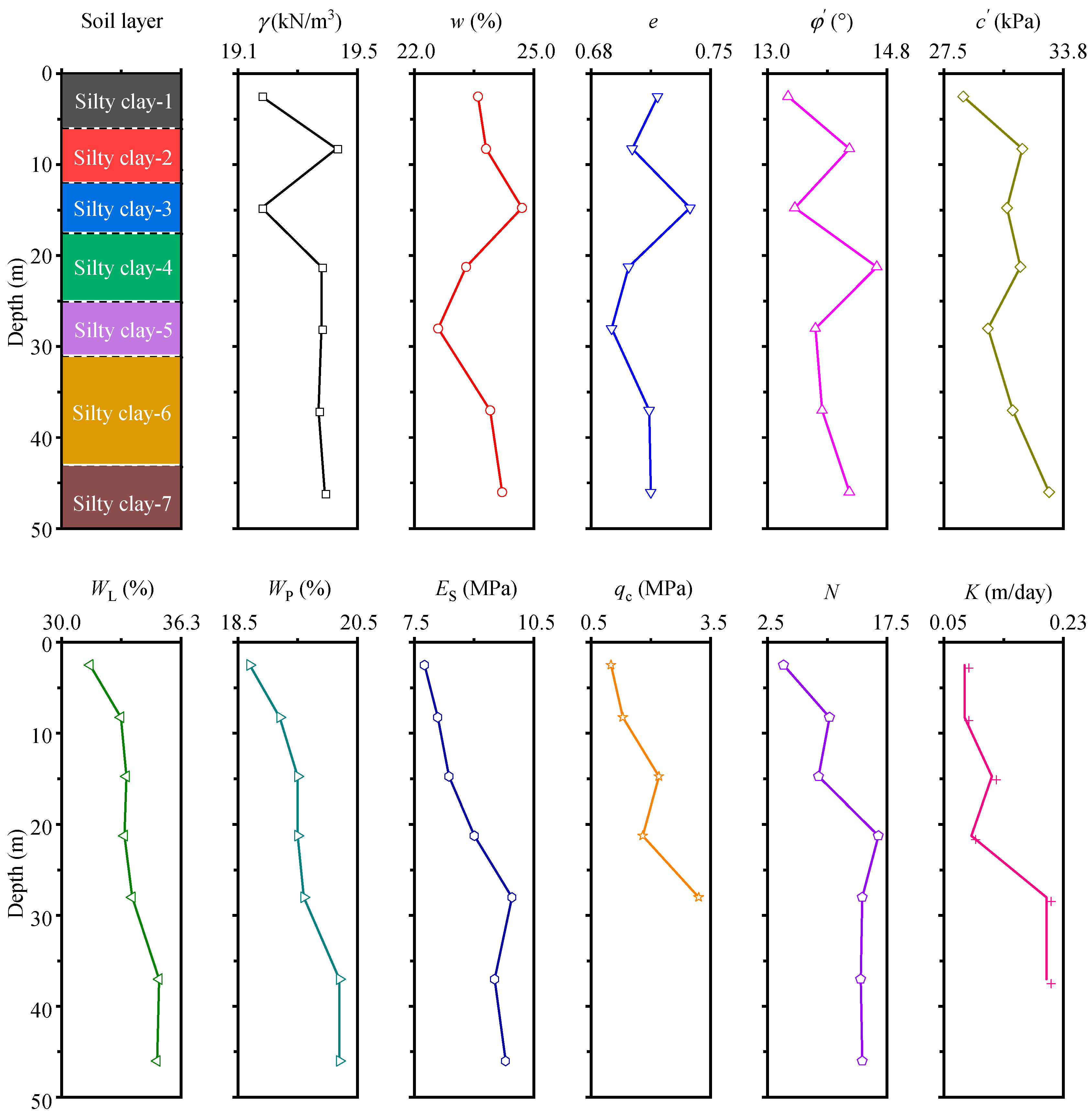


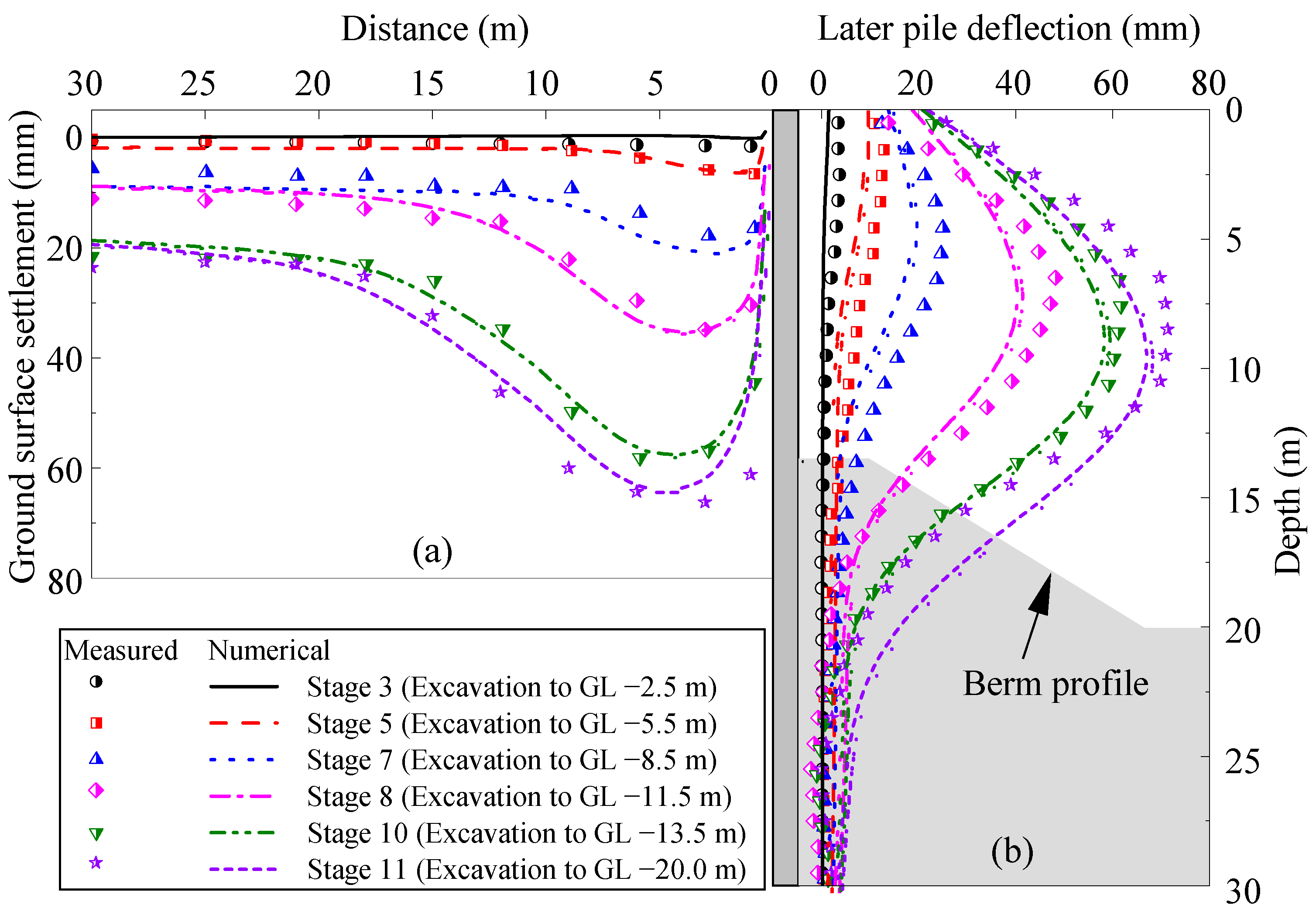
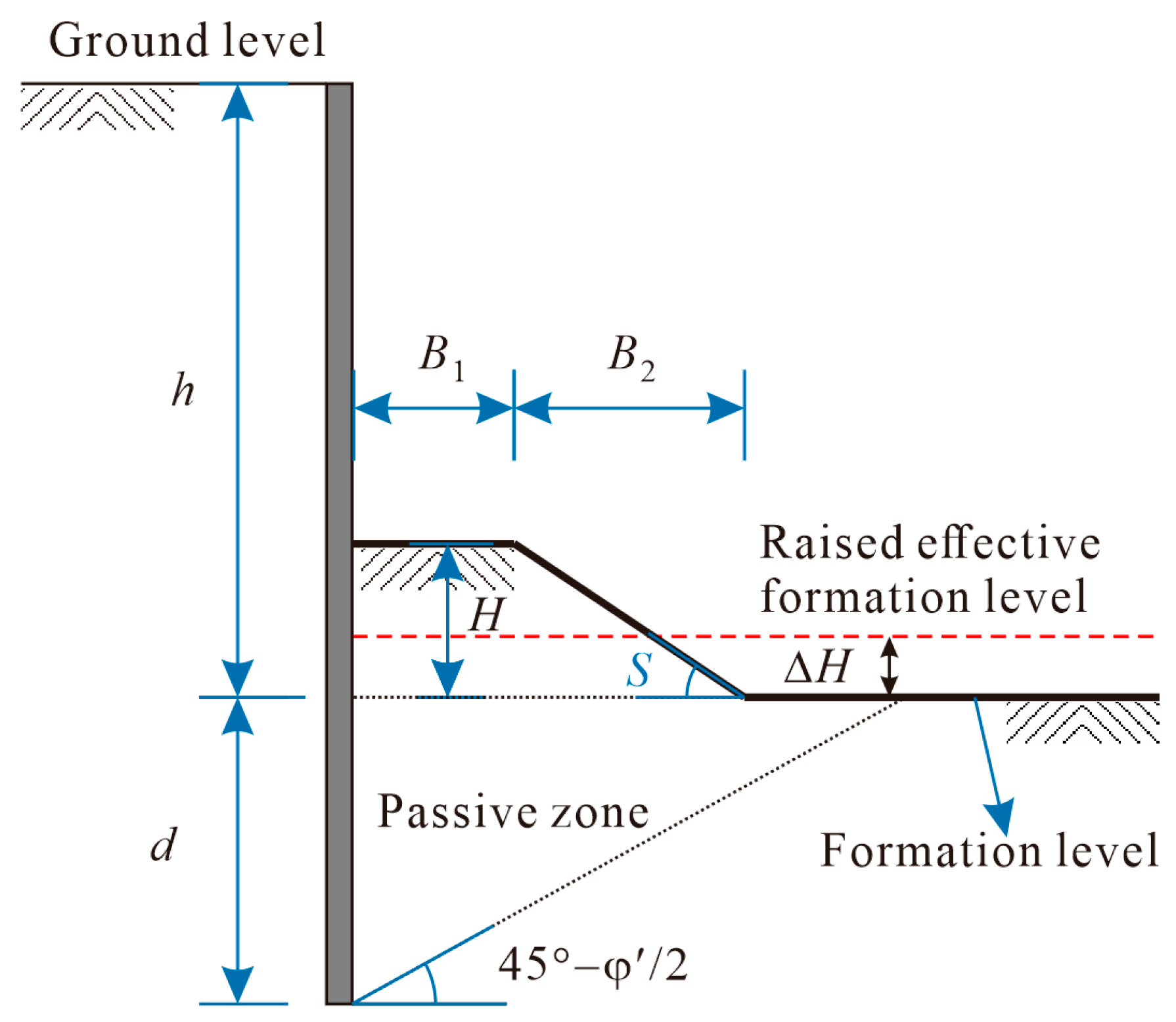
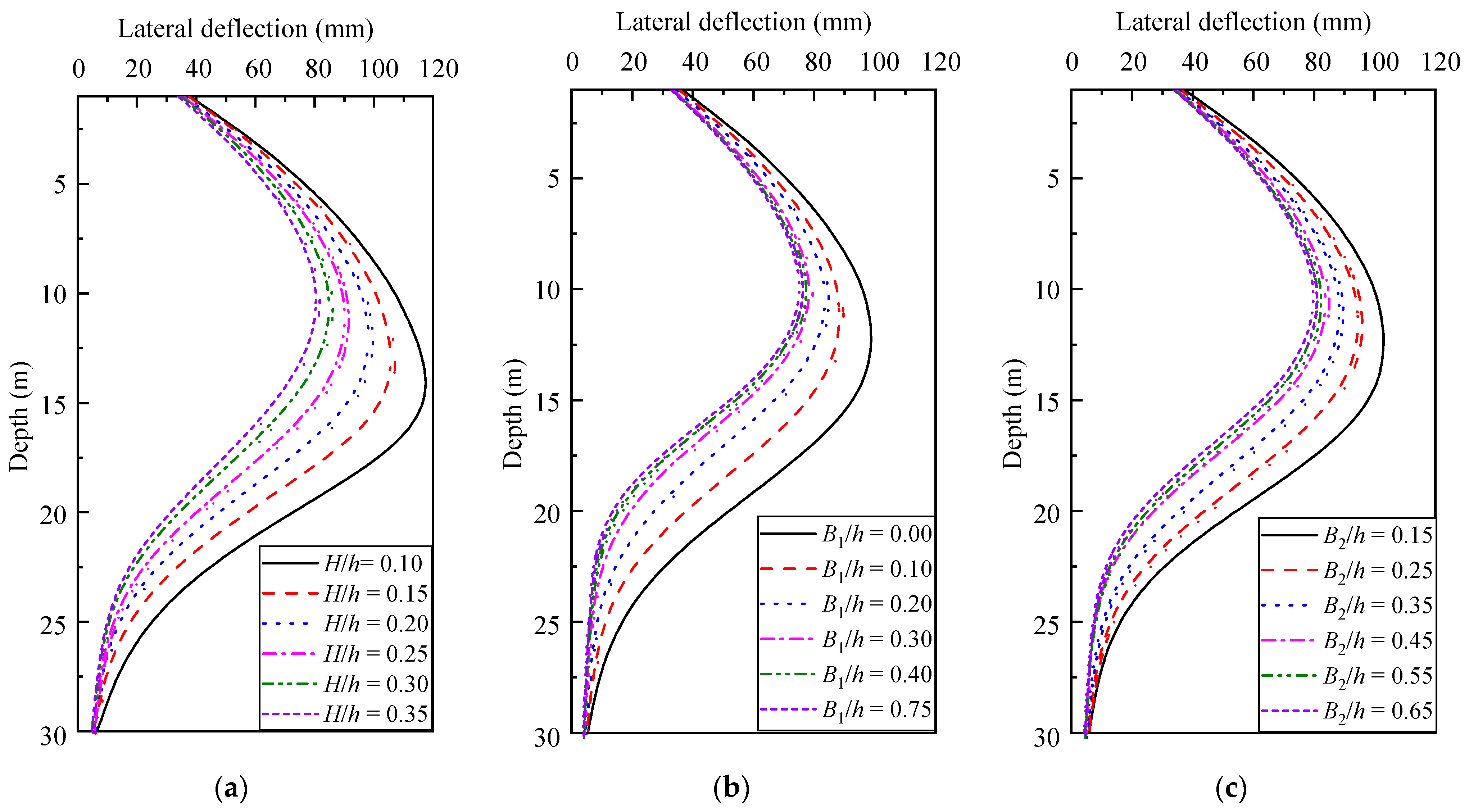

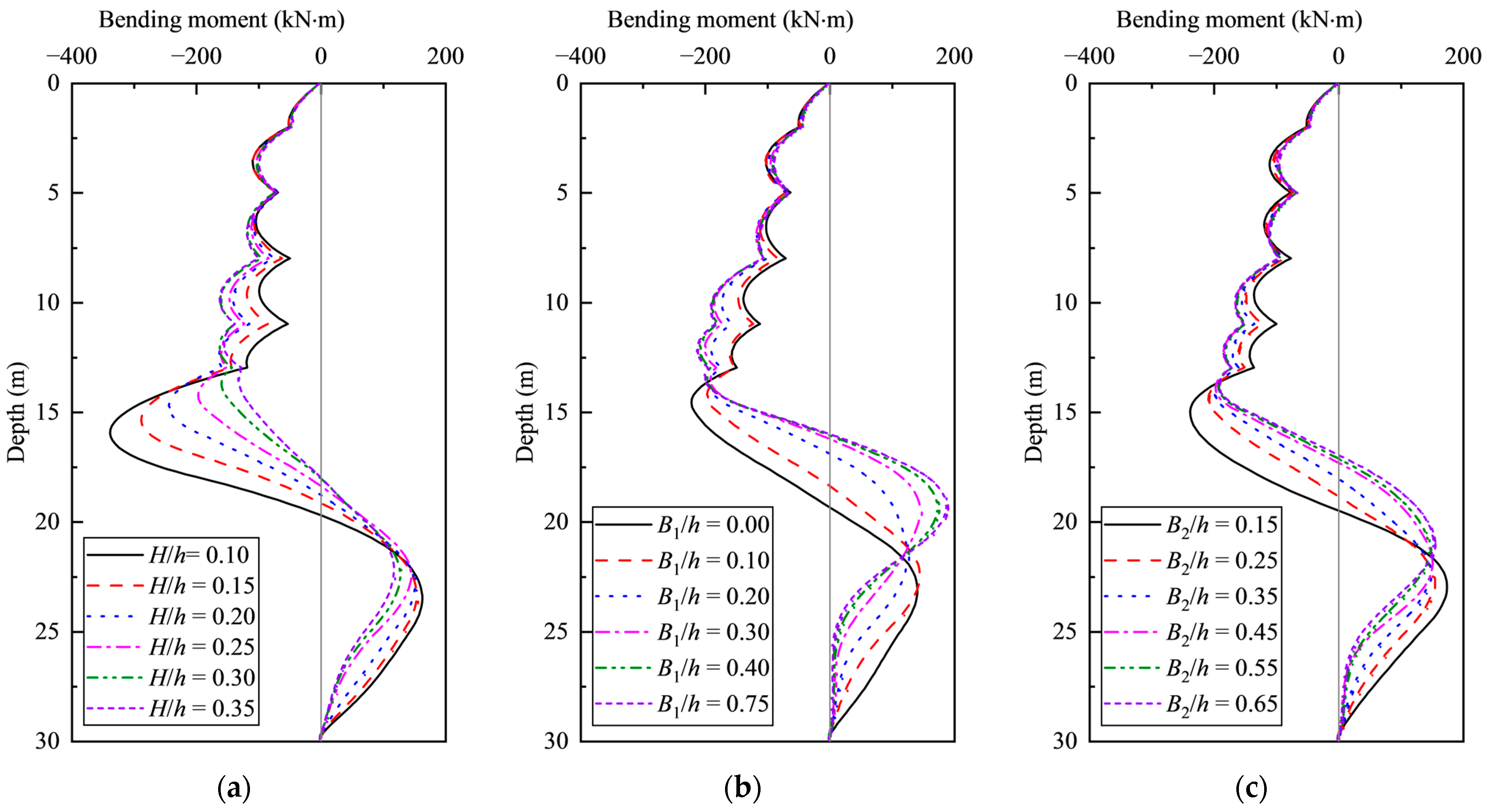

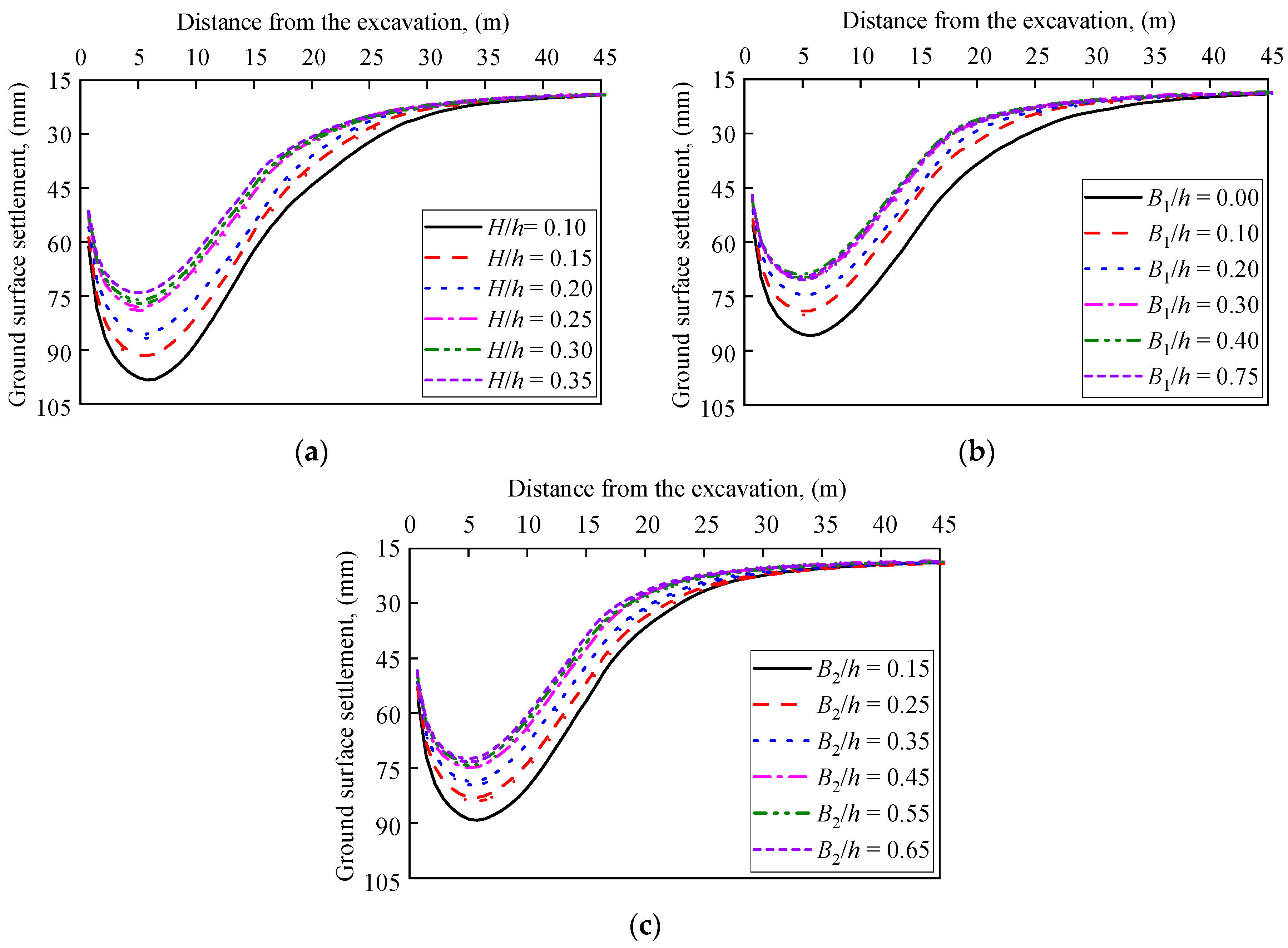
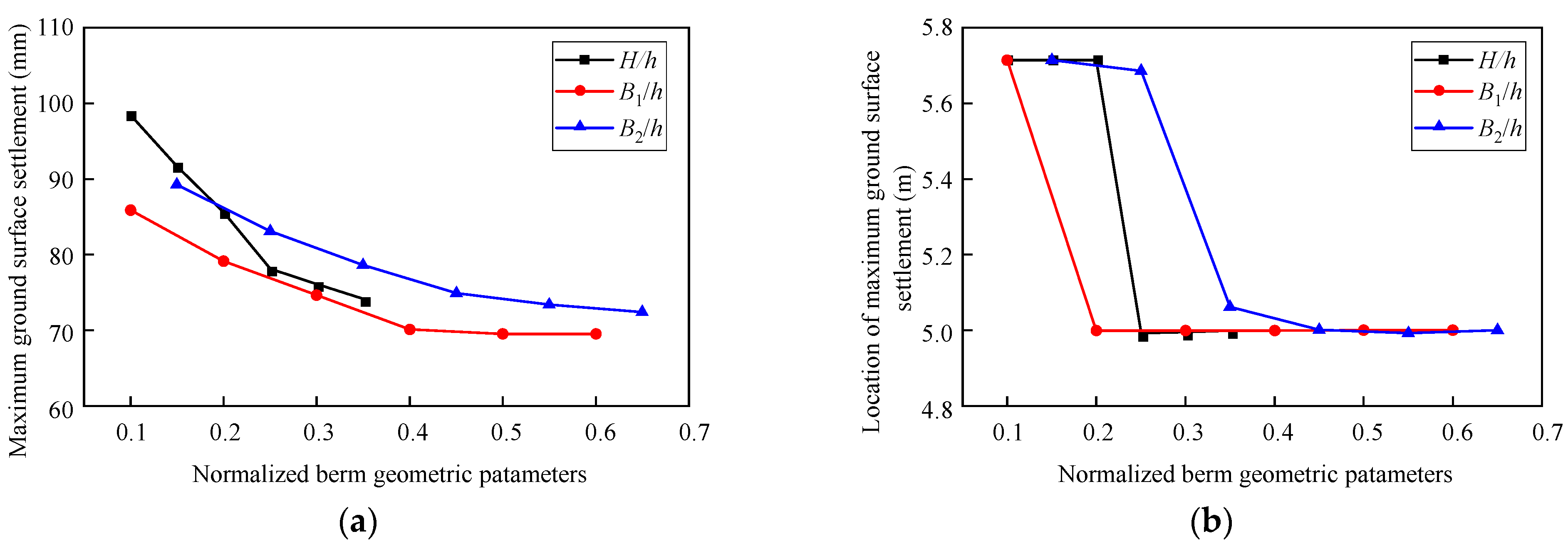

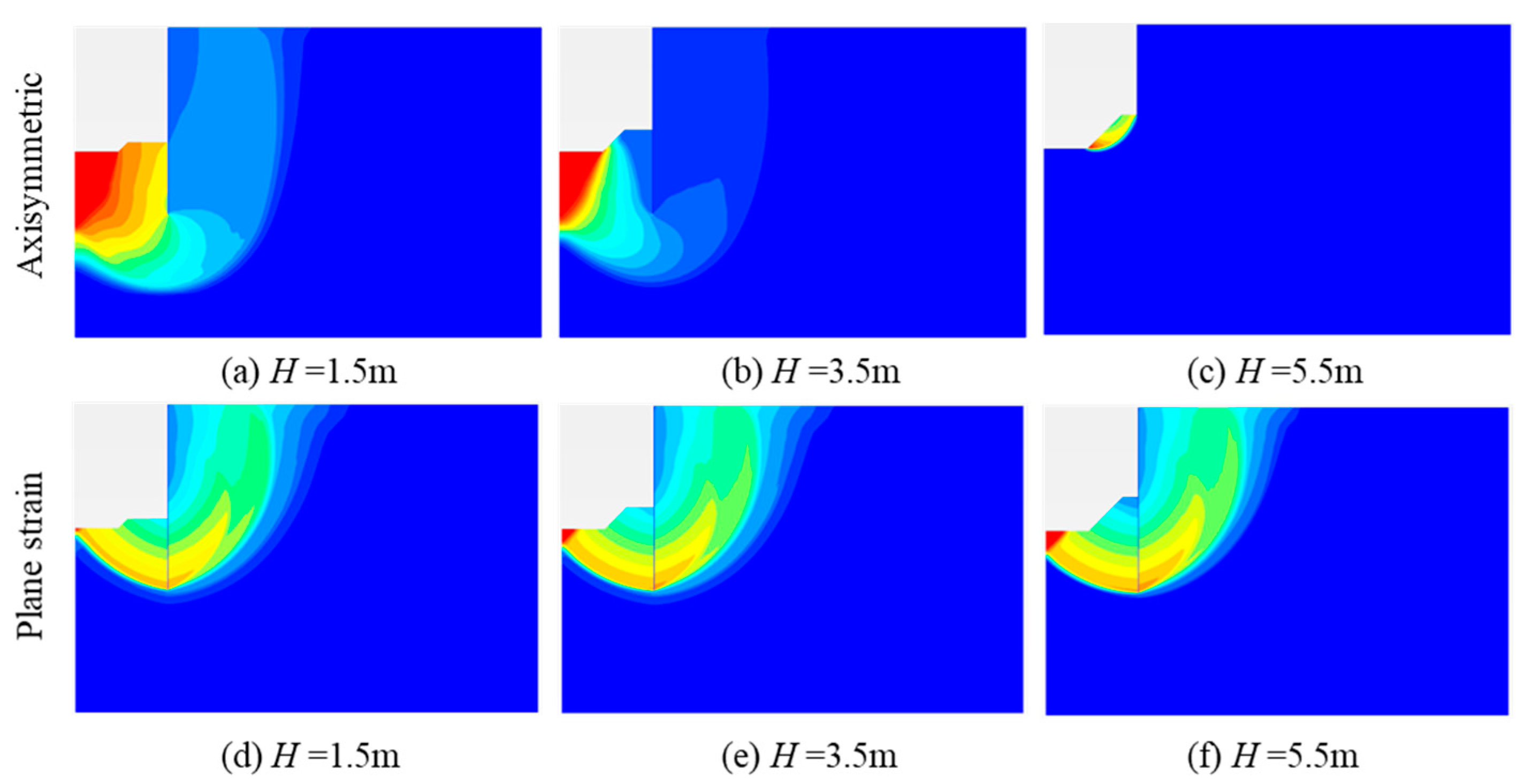
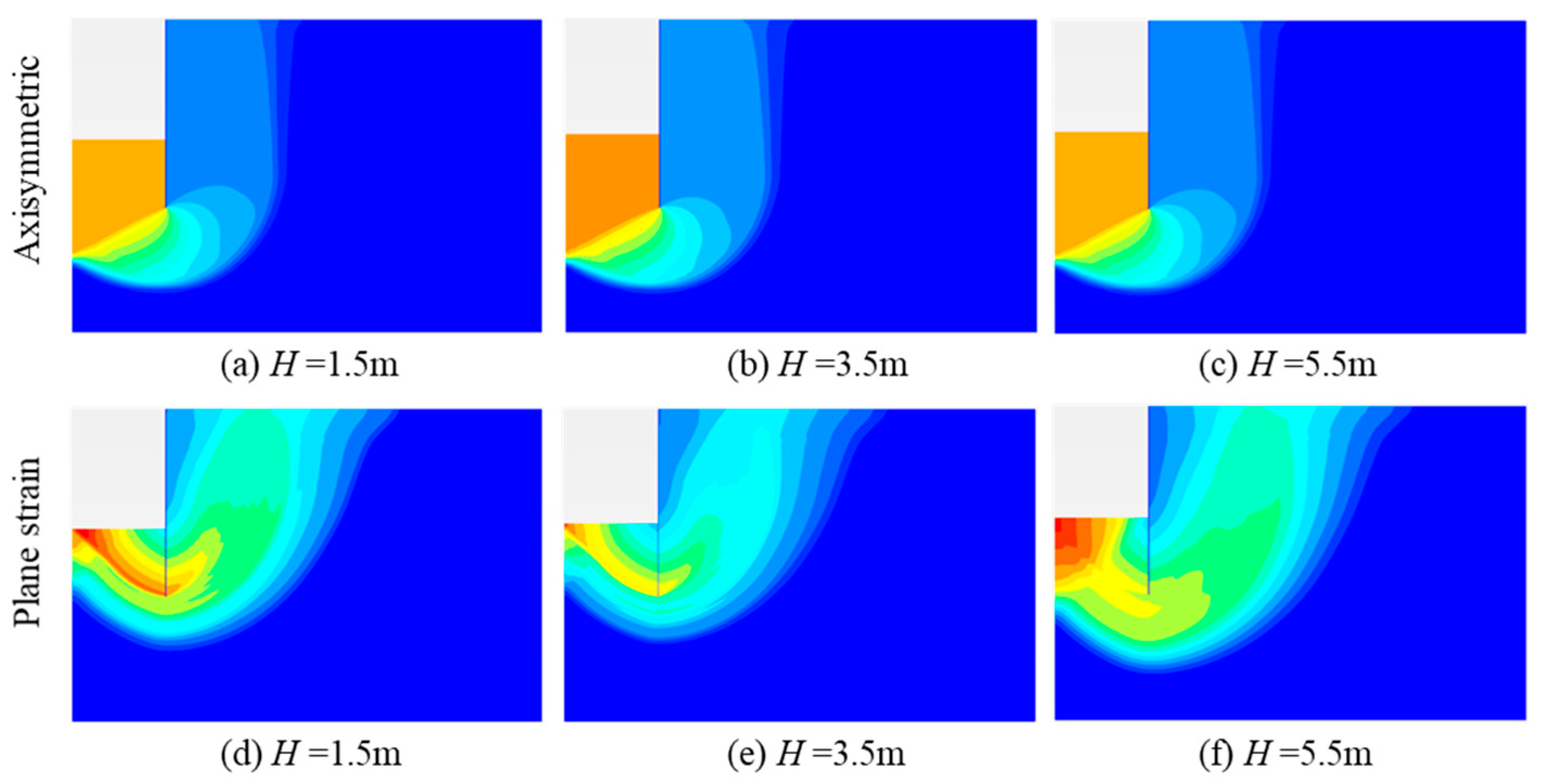

| Soil Layer | [kPa] | [°] | [MPa] | [MPa] | [MPa] | [kN/m2] | [10−4] | |||
|---|---|---|---|---|---|---|---|---|---|---|
| Silty clay-1 | 28.5 | 13.3 | 7.76 | 7.76 | 23.28 | 0.2 | 97.27 | 2.59 | 1.0 | 0.9 |
| Silty clay-2 | 31.6 | 14.2 | 8.09 | 8.09 | 24.27 | 0.2 | 99.44 | 2.48 | 1.0 | 0.9 |
| Silty clay-3 | 30.8 | 13.4 | 8.37 | 8.37 | 25.11 | 0.2 | 94.59 | 2.62 | 1.0 | 0.9 |
| Silty clay-4 | 31.5 | 14.6 | 9.01 | 9.01 | 27.03 | 0.2 | 99.73 | 2.87 | 1.0 | 0.9 |
| Silty clay-5 | 29.8 | 13.7 | 9.95 | 9.95 | 29.85 | 0.2 | 101.21 | 2.87 | 1.0 | 0.9 |
| Silty clay-6 | 31.1 | 13.8 | 9.52 | 9.52 | 28.56 | 0.2 | 97.99 | 3.28 | 1.0 | 0.9 |
| Silty clay-7 | 33.0 | 14.2 | 9.79 | 9.79 | 29.37 | 0.2 | 97.85 | 3.68 | 1.0 | 0.9 |
| Structural Element | Element Type | Size | E [MPa] | I [m4] | |
|---|---|---|---|---|---|
| Pile | Volume | 350 mm × 350 mm | 6.56 × 104 | 0.2 | -- |
| Waling | Beams | 350 mm × 350 mm | 2.06 × 105 | 0.2 | 3.98 × 10−4 |
| Steel plate | Plates | 8 mm thick | 2.06 × 105 | 0.2 | -- |
| Stage | Simulation Process | Calculation Type |
|---|---|---|
| 0 | The initial stresses were generated by the “K0” procedure | K0 procedure |
| 1 | Installation of retaining piles, crown beams, and laggings | Plastic |
| 2 | Reset displacement of soil and structures (A wished-in-place wall is adopted and installation effects are ignored) | Plastic |
| 3 | Excavation to GL-2.5 m, installation of 1st waling | Plastic |
| 4 | Dewatering to GL-6.5 m | Plastic |
| 5 | Excavation to GL-5.5 m, installation of 2nd waling | Plastic |
| 6 | Dewatering to GL-12.5 m | Plastic |
| 7 | Excavation to GL-8.5 m, installation of 3rd waling | Plastic |
| 8 | Excavation to GL-11.5 m, installation of 4th waling | Plastic |
| 9 | Dewatering to GL-21.5 m | Plastic |
| 10 | Excavation to GL-13.5 m, installation of 5th waling | Plastic |
| 11 | Excavation to GL-20.0 m | Plastic |
| 12 | Excavation to GL-20.0 m | Safety |
| Group No. | H/h | B1/h | B2/h |
|---|---|---|---|
| 1 | 0.10, 0.15, 0.20, 0.25, 0.30, 0.35 | 0.10 | 0.35 |
| 2 | 0.25 | 0.00, 0.10, 0.20, 0.30, 0.40, 0.75 | 0.35 |
| 3 | 0.25 | 0.10 | 0.15, 0.25, 0.35, 0.45, 0.55, 0.65 |
Disclaimer/Publisher’s Note: The statements, opinions and data contained in all publications are solely those of the individual author(s) and contributor(s) and not of MDPI and/or the editor(s). MDPI and/or the editor(s) disclaim responsibility for any injury to people or property resulting from any ideas, methods, instructions or products referred to in the content. |
© 2024 by the authors. Licensee MDPI, Basel, Switzerland. This article is an open access article distributed under the terms and conditions of the Creative Commons Attribution (CC BY) license (https://creativecommons.org/licenses/by/4.0/).
Share and Cite
Chen, L.; Guo, C.; Cao, D. Numerical Investigation of Earth Berm Effects on Prefabricated Recyclable Supporting Structure in Circular Excavations. Appl. Sci. 2024, 14, 4703. https://doi.org/10.3390/app14114703
Chen L, Guo C, Cao D. Numerical Investigation of Earth Berm Effects on Prefabricated Recyclable Supporting Structure in Circular Excavations. Applied Sciences. 2024; 14(11):4703. https://doi.org/10.3390/app14114703
Chicago/Turabian StyleChen, Lichao, Chengchao Guo, and Dingfeng Cao. 2024. "Numerical Investigation of Earth Berm Effects on Prefabricated Recyclable Supporting Structure in Circular Excavations" Applied Sciences 14, no. 11: 4703. https://doi.org/10.3390/app14114703
APA StyleChen, L., Guo, C., & Cao, D. (2024). Numerical Investigation of Earth Berm Effects on Prefabricated Recyclable Supporting Structure in Circular Excavations. Applied Sciences, 14(11), 4703. https://doi.org/10.3390/app14114703





